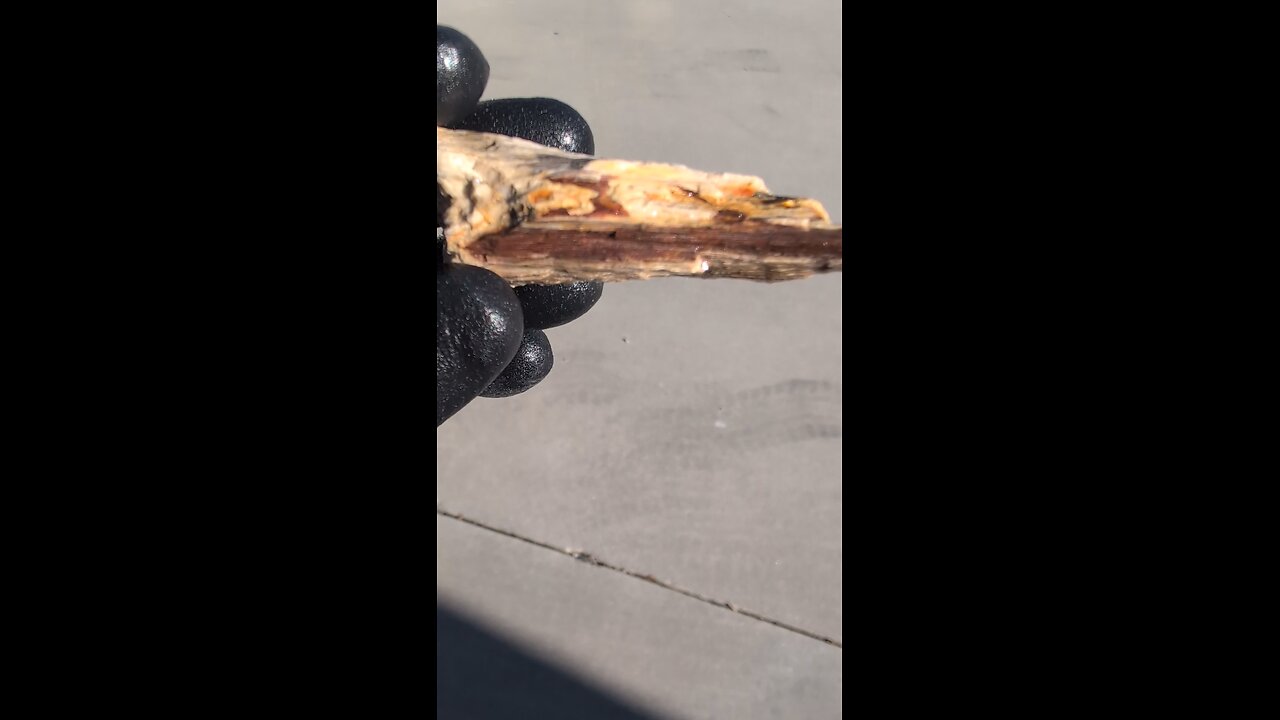Premium Only Content

Petrified wood!
Petrified wood is a type of fossil where the organic materials of a tree or tree-like plant have been replaced by minerals, preserving the original structure of the wood in stone form. Here are some key details about petrified wood:
Formation: The process of petrifaction involves several steps:
Burial: The wood must be buried quickly in sediment, usually in environments like river floodplains or volcanic ash deposits, to prevent decay.
Mineralization: Groundwater rich in dissolved minerals, primarily silica (but can also include iron, manganese, or other minerals), seeps into the wood. Over time, the minerals precipitate out of the water and replace the organic material cell by cell, effectively turning the wood into stone while maintaining its original structure.
Recrystallization: The silica often recrystallizes into quartz, preserving the cellular structure of the wood in fine detail.
Composition: While the primary mineral in petrified wood is often quartz, other minerals like calcite, pyrite, or oxides of iron and manganese can also be involved, contributing to the variety of colors seen in petrified wood.
Texture: Petrified wood retains the texture of the original wood, with growth rings, knots, and even bark sometimes visible. The texture can range from fine-grained to coarse, depending on the degree of mineral replacement and the type of wood.
Color: The color of petrified wood varies widely based on the minerals involved in the replacement process:
Silica: Usually results in white, gray, or clear petrified wood.
Iron Oxides: Can give shades of red, yellow, or brown.
Manganese Oxides: Often produce black or dark brown colors.
Copper Compounds: Can result in green or blue hues.
Uses:
Decorative: Petrified wood is popular in home decor, used for making furniture, tabletops, bookends, and as display pieces due to its unique beauty and historical significance.
Jewelry: Slices or small pieces of petrified wood can be polished and used in jewelry, especially when colorful or with interesting patterns.
Scientific Study: It's valuable in paleobotany for understanding ancient forests, plant evolution, and the environmental conditions of the past.
Geological Significance: Petrified wood provides a window into ancient ecosystems, showing what types of vegetation existed millions of years ago. It's also a record of geological processes like volcanic activity, flooding, or changes in river courses that led to the burial and preservation of the wood.
-
 2:03:36
2:03:36
FreshandFit
10 hours agoAkaash Replies to FreshandFit w/ Girls
165K16 -
 1:07:49
1:07:49
Man in America
10 hours agoBANNED TECH: The Tesla Secrets Rockefeller Crushed to Keep You Sick w/ Linda Olsen
26.7K4 -
 4:40:43
4:40:43
Drew Hernandez
23 hours agoCANDACE OWENS ASSASSINATION PLOT?
33.7K12 -
 1:05:15
1:05:15
Inverted World Live
8 hours agoOne Big Happy Thanksgiving | Ep. 147
76.6K5 -
 2:44:12
2:44:12
TimcastIRL
7 hours agoCandace Owens OFF AIR, Warns France Trying To KILL HER, Says Feds CONFIRM RECEIPT | Timcast IRL
214K177 -
 5:55:35
5:55:35
SpartakusLIVE
7 hours ago#1 King of Content ARRIVES, The Masses UNDULATE with EXCITEMENT
43.9K4 -
 15:51
15:51
Upper Echelon Gamers
8 hours ago $5.93 earned"INFLUENCERS" - House of LIES
22.8K3 -
 1:29:23
1:29:23
Glenn Greenwald
10 hours agoMarco Rubio, Europe Thwart Ukraine Peace Deal; NSA Illegally Leaks Steve Witkoff's Diplomatic Calls; Bari Weiss's Comically Out of Touch Plan for CBS | SYSTEM UPDATE #550
155K95 -
 51:15
51:15
State of the Second Podcast
11 hours agoCan You Trust Paid Gun Reviews? (ft. Tactical Advisor)
42.2K4 -
 8:56
8:56
MetatronGaming
9 hours agoSuper Nintendo NA vs PAL
42.9K10